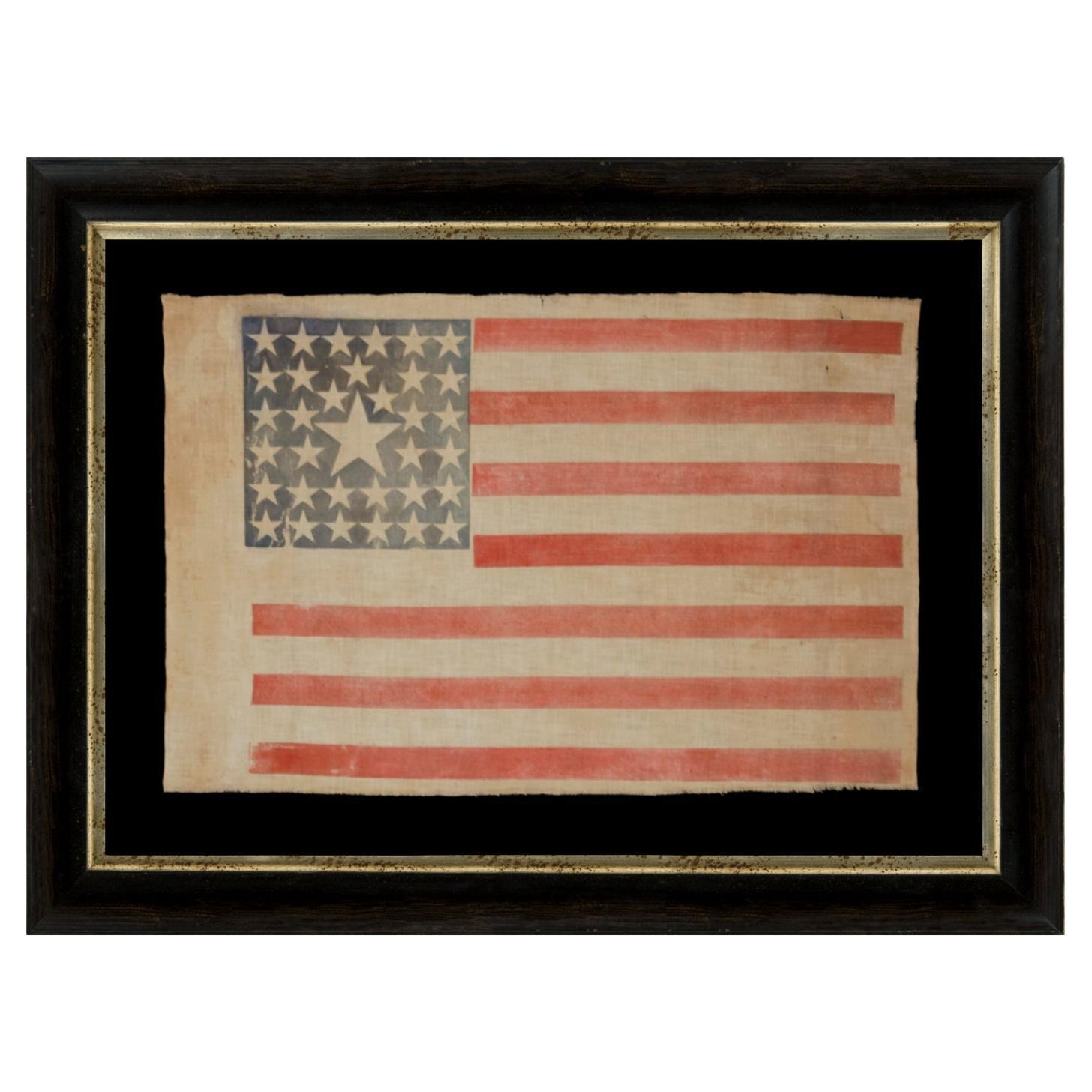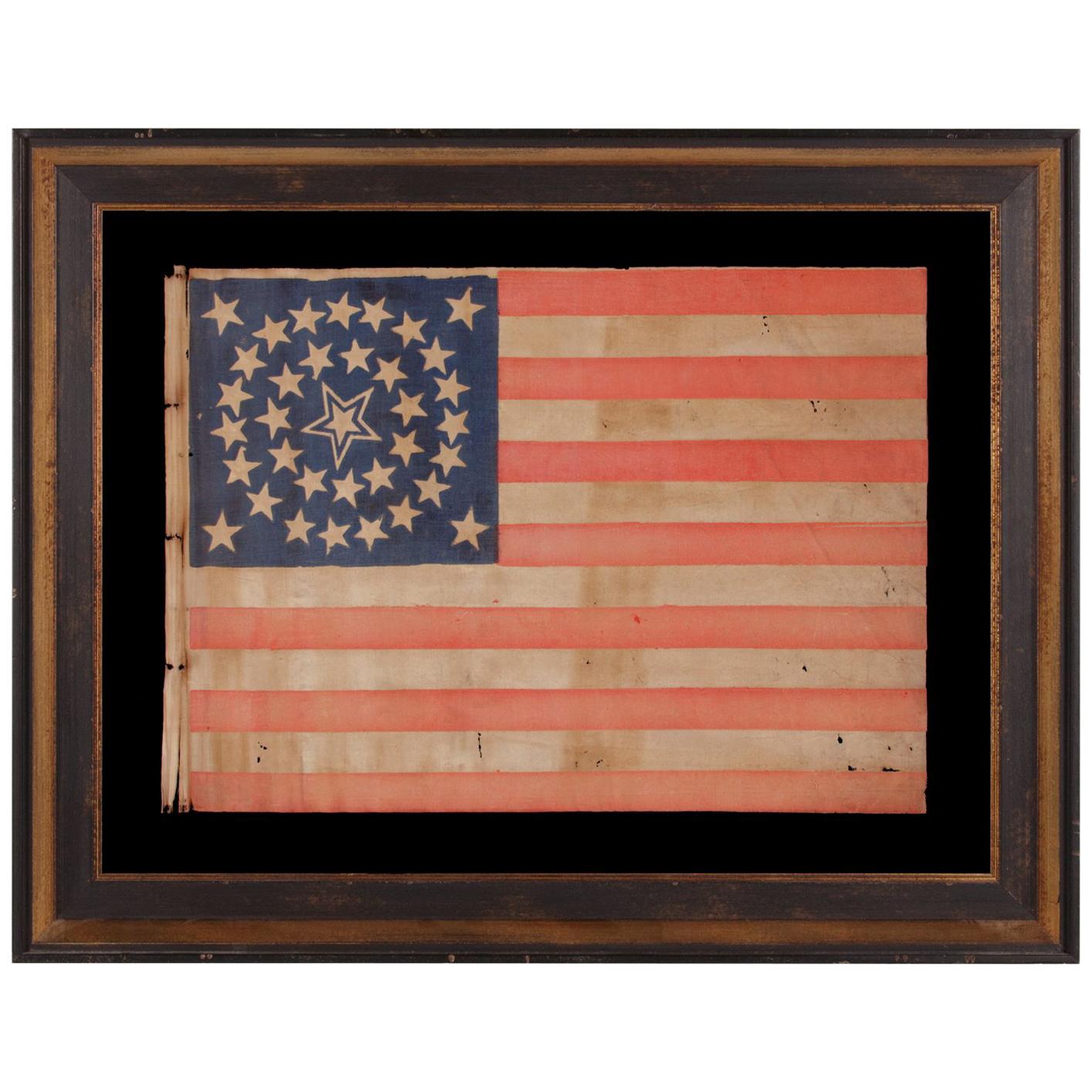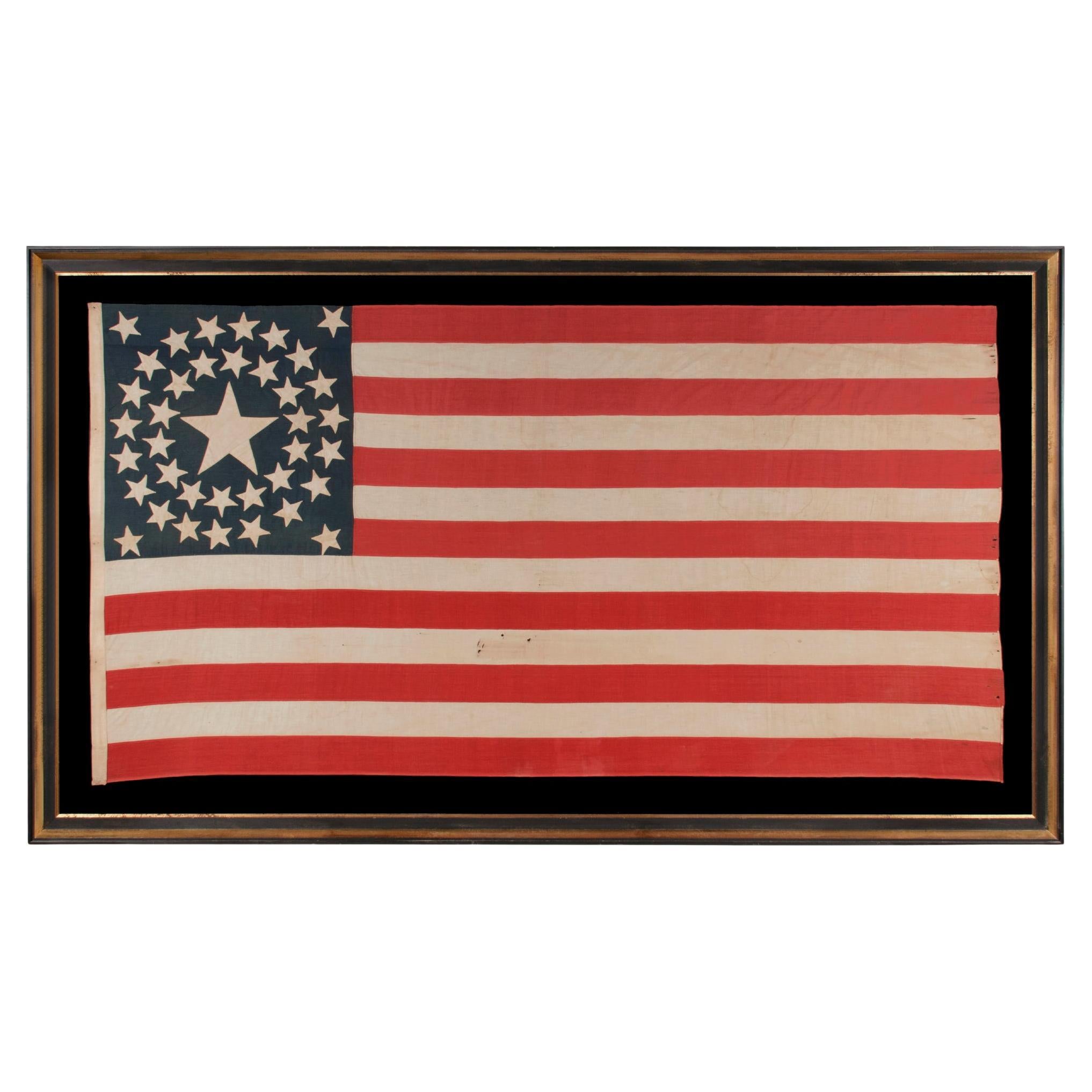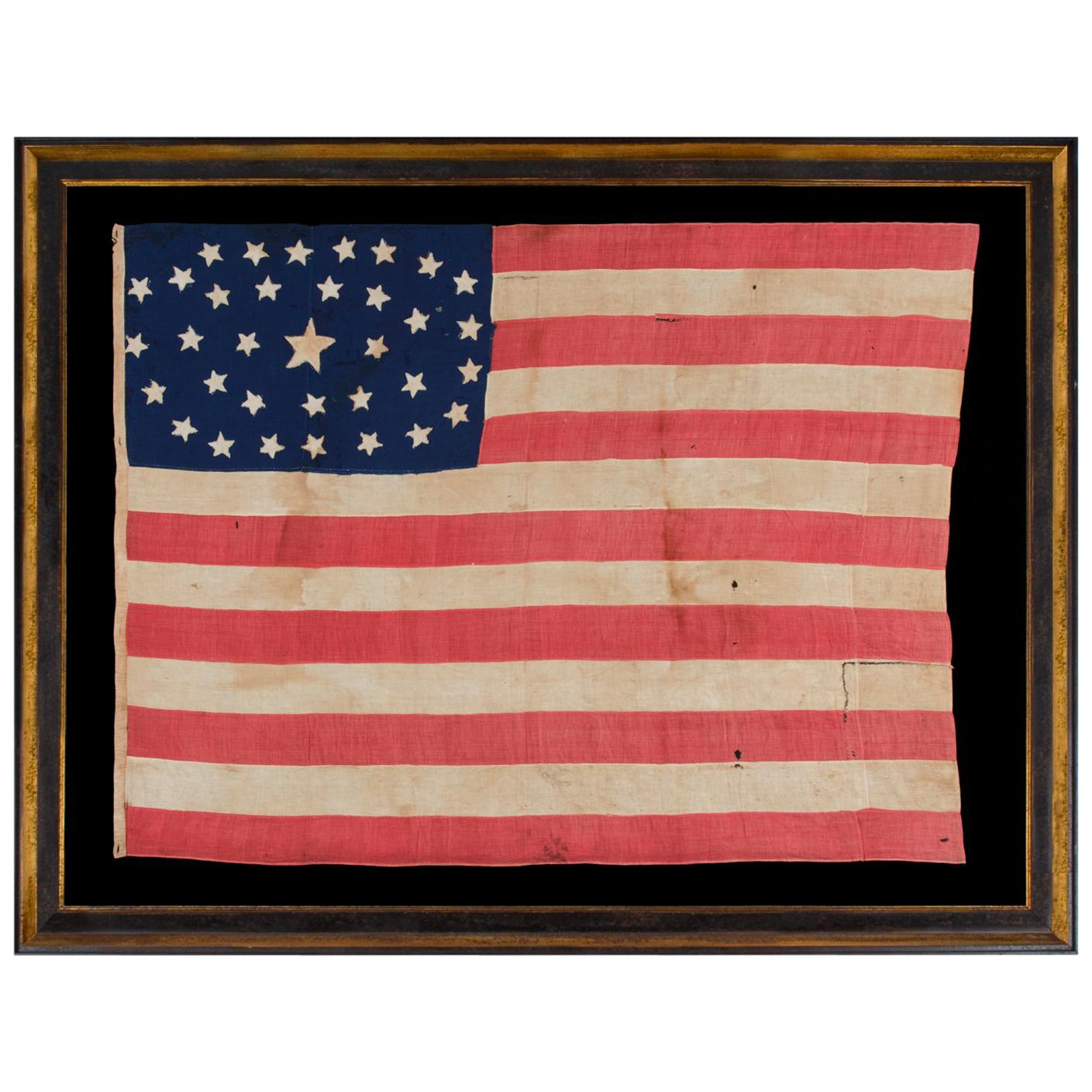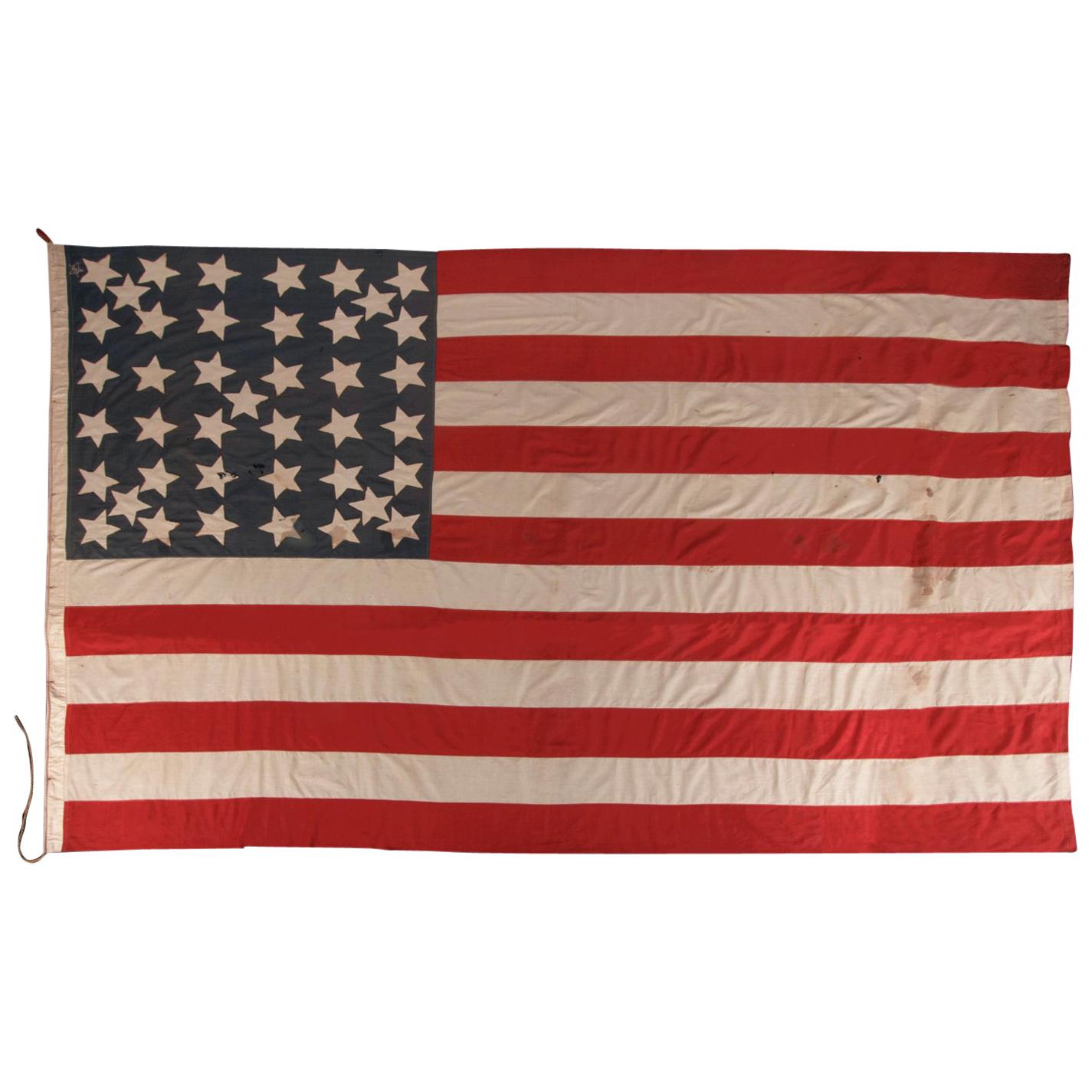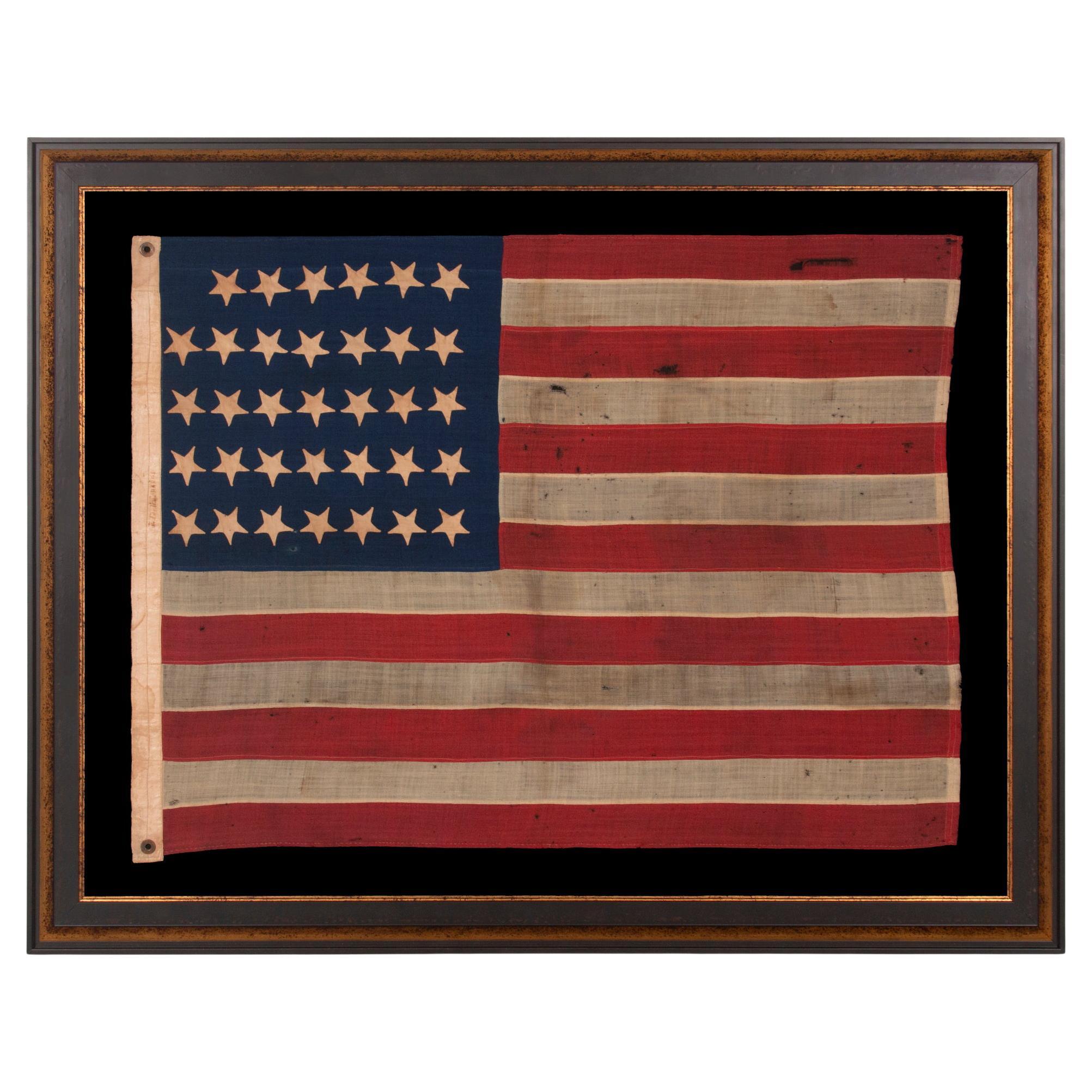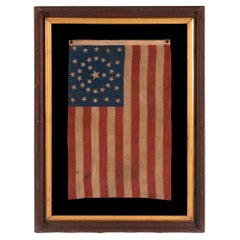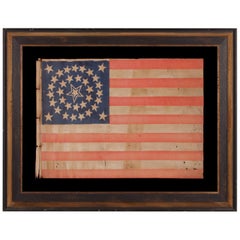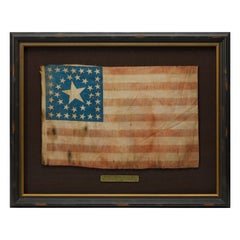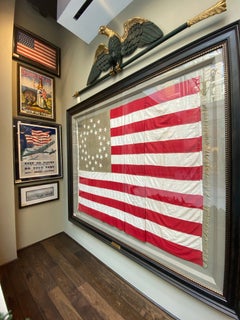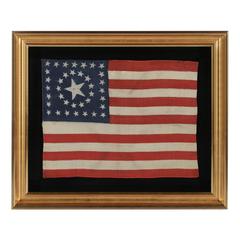
38 Stars in a Rare Circle-in-a-Square Medallion with a Huge Centre Star
View Similar Items
Want more images or videos?
Request additional images or videos from the seller
1 of 6
38 Stars in a Rare Circle-in-a-Square Medallion with a Huge Centre Star
About the Item
- Dimensions:Height: 37.25 in (94.62 cm)Width: 44.5 in (113.03 cm)Depth: 2.5 in (6.35 cm)
- Place of Origin:
- Period:
- Date of Manufacture:1876
- Condition:See Item Description.
- Seller Location:York County, PA
- Reference Number:Seller: 38j-10281stDibs: LU84976188513
About the Seller
5.0
Recognized Seller
These prestigious sellers are industry leaders and represent the highest echelon for item quality and design.
Established in 1991
1stDibs seller since 2008
61 sales on 1stDibs
Typical response time: 10 hours
More From This SellerView All
- 34 Star Flag with Stars in a Rare Pattern, Huge Center Star, Kansas StatehoodLocated in York County, PA34 STARS IN A VERY RARE PATTERN THAT FEATURES A HUGE CENTER STAR IN THE MIDST OF A LINEAL STAR PATTERN, ONE-OF-A-KIND AMONG KNOWN EXAMPLES, CIVIL WAR PERIOD, 1861-63, KANSAS STATEHOOD Early flags are collected for many reasons, but one of the primary factors can be found in the mere fact that they looked so very different in early America than they do today. Because there was no official star configuration for the American national flag until 1912, their design was left to the whims of the flag-maker. Artist’s liberty and creative expression led to a host of various star patterns. Among these are not only rows and columns of stars, but circular formations, star-shaped formations, and all manner of other arrangements that span from the common and benign to the exceptionally rare and whimsical. One of the earliest concepts in the layout of the stars was to feature a large one in the center of the blue canton amidst an otherwise lineal configuration. Because so few flags survive from the first fifty years following our independence, scant few examples exist with this feature, but it can be seen on the only known 17-star, 17-stripe flag (1803-1812), for example, that has so-far been discovered, as well as a fragment of the another flag that was found alongside it. It can also be seen on a rare, 24-star example (1821-1836), as well as a particular early, 13-star flag that probably pre-dates 1830 and might be 18th century. In the case of printed parade flags, like this one, I can think of only two examples, each of which survives as the only known flag in its respective style. Neither of these has thus far been documented in any text. This is one of those two, exceptionally rare flags...Category
Antique 1860s American Political and Patriotic Memorabilia
MaterialsCotton
- 34 Star Antique American Flag with Rare Circle-in-a-square PatternLocated in York County, PA34 star antique american flag with an exceptionally rare circle-in-a-square configuration and a “y” formation of stars in the center, one of just three or four known examples in this style; opening two years of the civil war, 1861-1863, kansas statehood, possibly a union army camp colors: 34 star American national flag, printed on a wool and cotton blended fabric. The stars are arranged in an exceedingly rare type of medallion star pattern. This consists of a large center star, flanked by 3 stars, which together present in a “Y” formation. This is surrounded by a circular wreath of 14 stars, and then again by 16 more that skirt the perimeter of the blue canton, roughly placed in a square, but with uneven edges. The end result is a variant of what I have termed a “circle-in-a-square” medallion, with a “Y” in the center. Because there was no official star configuration for the American flag until 1912, the design was left to the whims of the maker. Most flags display their stars in lineal rows or columns. Circular medallions fall upon the next rung on the ladder in terms of rarity, comprised of two or three consecutive wreaths, usually with a star in each corner and one in the center, followed by what is known as the “Great Star” pattern, a star made out of stars, which is far more rare and coveted by collectors. Then there are even rarer patterns, such as the circle-in-a-square, which appears most often in 38 and 34 star flags, though it does survives on flags in other star counts. I clearly recall just two other flags in this precise variation, both of which I have had the privilege to own. One of these is presently in the collection of the George Washington University Museum and The Textile Museum, as part of the Washingtoniana Collection of Albert Small. One of the reasons this design is so interesting is because it is unusual, but another is because it has such a strong graphic presence. Note how the stars point in a variety of directions on their vertical axis. Also note the attractive color of the canton, which falls somewhere between cornflower blue and indigo. When combined with the exceptionally rare configuration and a Civil War period date, these traits result in an exceptional example among 19th century flags. The top and bottom edges of the flag were bound with treadle stitching. There is a treadle-sewn, cotton binding along the hoist with two, tiny, brass grommets. It is my opinion that this flag likely saw military use as a Union Army camp colors, made to mark a military encampment and for military drilling within the camp. Although the hoist measurement is atypically small, and not in line with Army regulations, the length is congruent with identified camp flags...Category
Antique Mid-19th Century American Political and Patriotic Memorabilia
MaterialsCotton
- 35 Stars in a Medallion Configuration with a Large Haled Center StarLocated in York County, PA35 STARS IN A MEDALLION CONFIGURATION WITH A LARGE, HALOED CENTER STAR, CIVIL WAR PERIOD, WEST VIRGINIA STATEHOOD, 1863-65 35 star American national parade flag, printed on cotto...Category
Antique 1860s American Political and Patriotic Memorabilia
MaterialsCotton
Price Upon Request - 34 Star American flag, Updated to 39 Stars, with Stars in a Great Star PatternLocated in York County, PA34 STARS IN A WHIMSICAL RENDITION OF THE GREAT STAR PATTERN, ON A CIVIL WAR PERIOD FLAG WITH A CORNFLOWER BLUE CANTON, UPDATED TO 39 STARS IN 1876 34 star American national flag with additional stars added and one of the most stunning graphic designs I have ever seen in early flag-making. The original pattern was comprised of a circle of 5 large stars, and triangular arms made of smaller stars. These are noticeable pointy and bent like the arms of a starfish. Made of cotton, the stars are hand-sewn and double-appliquéd to a fantastic, cornflower blue canton, a color common to Civil War uniforms...Category
Antique 1870s American Political and Patriotic Memorabilia
MaterialsCotton
- 38 Star Parade Flag with Whimsical 6-Pointed Stars, Colorado StatehoodLocated in York County, PA38 WHIMSICAL STARS, WITH 6-POINTED PROFILES, SIMILAR TO THE STAR OF DAVID, ON AN ANTIQUE AMERICAN FLAG OF THE CENTENNIAL ERA; A REMARKABLE SPECIMEN, ONE-OF-A-KIND AMONG KNOWN EXAMPLE...Category
Antique Late 19th Century American Political and Patriotic Memorabilia
MaterialsCotton
Price Upon Request - 38 Star American Flag, Stars in Notched Pattern, ca 1876-1889Located in York County, PA38 HAND-SEWN STARS IN A "NOTCHED" PATTERN, ON AN ANTIQUE AMERICAN FLAG WITH BEAUTIFUL WEAR FROM HAVING BEEN EXTENSIVELY FLOWN, MADE AT THE TIME WHEN COLORADO WAS THE MOST RECENT STATE TO JOIN THE UNION, 1876-1889 38 star Antique American flag, made during the period when Colorado was the most recent state to join the Union. The stars are arranged in what is known as a "notched" pattern, in which two spaces were left open along the hoist end, in the first and last rows, in anticipation that two more Western Territories would soon join the Union. The latter 19th century was a time of when much of the land in and about the Continental Divide was formalized into states, and there was continual speculation about which ones would be accepted next, and with what boundaries. The stars of the flag are made of cotton and are double-appliquéd (applied to both sides) with a lineal, treadle stitch. The canton and stripes of the flag are made of wool bunting that has been pieced with treadle stitching. The canton was constructed from five separate lengths of fabric, which is an unusual feature, though hardly unknown. To each of these a row of stars was sewn. This manner of construction is sometimes encountered and tends to be an early trait, at least when it occurs in flags of this scale and smaller. When encountered, it also seems to have been preferred in flags meant for maritime use. While the feature does not by any means guarantee this fact, it is a reasonable, educated guess, based upon my examination of many other examples. A flag with a 5-piece canton, such as this, would have been less likelihood to stretch, with increased structural integrity. The alternative is that this was simply an example made when there were at least five pieces of leftover fabric, of a reasonable size to made individual rows, and that what it actually demonstrates is the careful conservation of scarce resources. There is a sailcloth canvas binding along the hoist, with 3 brass grommets, evenly spaced. Perhaps the best feature of the flag is the evidence it displays of having been extensively flown, with the fly end whipped out from wind exposure. While many flags display damage from a combination of having been flown, exposure to the elements, various mishaps, and improper storage, very few exhibit wear such as this, which is both endearingly and visually attractive. This one shows its age beautifully, whipped out along the fly end, with losses that convey an element of movement, that most flags don’t capture in the state in which they survive. Colorado became the 38th state on August 1st, 1876. This was the year of our nation’s 100-year anniversary of independence. Per the Third Flag Act of 1818, stars were not officially added until the 4th of July following a state's addition. For this reason, 37 was the official star count for the American flag in 1876. Flag-making was a competitive venture, however, and few flag-makers would have been continuing to produce 37 star flags, when their competitors were making 38’s. It is for this reason that 38 and 13 stars (to represent the original 13 colonies...Category
Antique Late 19th Century American Political and Patriotic Memorabilia
MaterialsWool
Price Upon Request
You May Also Like
- 38-Star Antique American Flag with Unique Canton, circa 1876-1890Located in Colorado Springs, COThis is a striking 38-star American flag. The flag dates to 1876-1890, when Colorado (represented by the large star in the center of the flag’s canton) joined the Union as the 38th s...Category
Antique Late 19th Century American Political and Patriotic Memorabilia
MaterialsMuslin
- 46-Star American Flag Printed in Drum Star ConfigurationLocated in Colorado Springs, COThis is an original 46-Star American parade flag, celebrating Oklahoma statehood. Each star on the flag's canton represents a state in the Union at the time. The official flag design would update every July 4th, to include any new states added to the Union in the past year. Oklahoma, the 46th state, entered the Union on November 16, 1907. As such, this 46–star flag was the official flag of the United States from July 4, 1908, until July 4, 1912. The silk flag has a dark blue canton with 46 white printed stars. The stars are printed in an 7-8-8-8-8-7 row configuration, or “Drum design.” The flag design is completed with 13 alternating red and white stripes, each stripe representing one of the original thirteen colonies. The land that comprises Oklahoma today was added to the United States as part of the Louisiana Purchase of 1803. Throughout the 19th century, the U.S. government relocated Indian tribes from the southeastern United States to the area, and by 1900, over 30 Indian tribes had been moved to what was originally called the Indian Territories. At the same time, ranchers in Texas began to move into the area in search of new pasture lands. Although stipulations in the Indian Relocation Act agreed that the land would forever be Indian Territory, the promise of fertile farmland trumped the government’s promise of sovereignty. On April 22, 1889, they opened the land to settlement by homesteaders, creating a land run in which settlers, called “Boomers,” were allowed to cross the Texas or Arkansas border at a particular hour to claim homesteads. Settlers who illegally crossed the border earlier to stake prime land were called “sooners,” which eventually became the state’s nickname. Wagons and the Santa Fe railroad carried cartloads of men and women to blank town sites and building plots, creating ten thousand-people communities in a matter of days. The following year, the region was further divided into Indian Territory and Oklahoma Territory...Category
Vintage 1910s American Political and Patriotic Memorabilia
MaterialsSilk
- 36-Star American Flag, Hand-Cut and Sewn, Civil War Era with Rare PatternLocated in Colorado Springs, COThis a 36-star medallion American flag, with a magnificent and rare star pattern and campaign connection. 36 stars celebrate the addition of Nevada to the Union and officially flew f...Category
Antique 1860s American Historical Memorabilia
MaterialsCotton
- 39-Star Antique American Flag with 'Whimsical' Star Pattern, 1889Located in Colorado Springs, COThis is a 39-star unofficial American flag, handmade and printed on cotton. The flag dates to 1889 and has a unique history, thanks to its rare star-count. The flag’s canton is prin...Category
Antique 1880s American Political and Patriotic Memorabilia
MaterialsCotton
- Rare Monumental 1890 Antique 42 Star United States of America FlagLocated in Dayton, OHMonumental fifteen foot 42 star American flag, circa 1889-1890. The 42-star flag is rare because only a limited number of 42-star flags were produced after Washington became a state on Nov. 11, 1889. But it takes a more intimate knowledge of flag trivia to know just why it happened this way. White stars are added to the blue field of the star-spangled banner on the Fourth of July after a state is admitted to the union. In the fall of 1889, several western territories became states. Dakota was admitted, and then split into North and South Dakota, on Nov. 2, 1889, which made them state and star numbers 39 and 40. Montana was named the 41st state on Nov. 8, followed by Washington, on Nov. 11. Only a few flag manufacturers began producing 42-star flags before the official addition of the 42nd star on July 4, 1890. Those who tried to jump the gun by being the first to produce an up-to-date flag were surprised when Idaho was admitted to the United States on July 3...Category
Antique 1890s American Classical Historical Memorabilia
MaterialsCotton
- 34-Star Civil War American Flag, Antique Great Star Pattern, circa 1861Located in Colorado Springs, COThe stars of this extremely rare, Civil War-era flag are arranged in what is sometimes called the "Great Flower" pattern, a large star made out of smaller stars -- named as such beca...Category
Antique 1860s American Political and Patriotic Memorabilia
MaterialsLinen
$15,500 Sale Price37% Off
